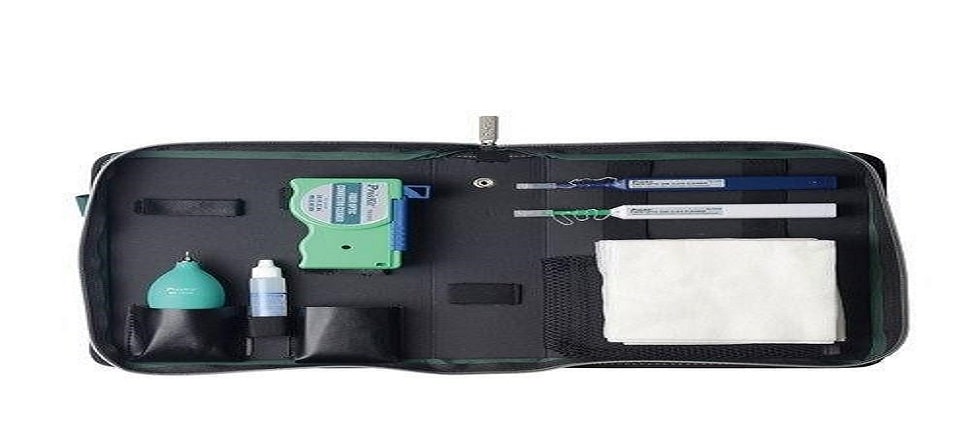Fiber optic technology has revolutionized the telecommunications industry, providing faster and more reliable data transmission than traditional copper cables. To maintain optimal performance, fiber optic cables require regular cleaning to remove dust, dirt, and other contaminants that can degrade signal quality. In this article, we will explore the importance of fiber optic cleaning and highlight the key components of basic cleaning kits suitable for both home and industrial applications.
1. The Importance of Fiber Optic Cleaning
In the world of fiber optics, cleanliness is paramount. Even the tiniest speck of dust or dirt on a fiber optic connector can cause signal loss, increased reflectance, and overall performance degradation. Proper cleaning and maintenance are essential to ensure reliable data transmission and prevent costly downtime.
2. Understanding Fiber Optic Contaminants
Fiber optic connectors can be contaminated by various particles, such as dust, oil, fingerprints, and moisture. These contaminants can accumulate on the end face of the connector and interfere with the transmission of light signals. Regular cleaning helps remove these contaminants and prevents signal loss.
3. Components of a Basic Fiber Optic Cleaning Kits
A basic fiber optic cleaning kit typically includes the following components:
a) Cleaning Solution
A cleaning solution specifically formulated for fiber optics is crucial for effective cleaning. It should be free of particles and residue that could further contaminate the connectors. Isopropyl alcohol (IPA) is commonly used as a cleaning solution due to its excellent cleaning properties.
b) Cleaning Swabs
Cleaning swabs with lint-free, non-abrasive tips are used to apply the cleaning solution to the fiber optic connectors. They should be designed to prevent shedding or leaving behind fibers that can cause further contamination.
c) Cleaning Wipes
Lint-free cleaning wipes are essential for removing excess cleaning solution and absorbing any remaining contaminants. They should be made of materials that won’t scratch or damage the connector surface.
d) Connector Cleaning Tools
Connector cleaning kits, such as a connector cleaner or a cleaning stick, provide a convenient and reliable way to clean fiber optic connectors. These tools are designed to safely remove contaminants without damaging the delicate fiber optic end face.
e) Inspection Scope
An inspection scope, also known as a fiber optic microscope, is used to examine the cleanliness and quality of fiber optic connectors. It helps identify any remaining contaminants or damage that may affect signal performance.
4. Step-by-Step Guide to Cleaning Fiber Optic Connectors
Proper cleaning of fiber optic connectors involves the following steps:
1. Inspect the connector using an inspection scope to identify any visible contaminants or damage.
2. Apply a small amount of cleaning solution to a lint-free cleaning swab.
3. Gently wipe the end face of the connector using the swab, using a back-and-forth motion.
4. Inspect the connector again to ensure it is clean and free from contaminants.
5. If necessary, repeat the cleaning process until the connector is clean.
6. Once clean, use a dry, lint-free cleaning wipe to remove any excess cleaning solution.
5. Cleaning Fiber Optic Patch Cables
Fiber optic patch cables play a crucial role in connecting various network devices. To clean fiber optic patch cables effectively, follow these steps:
1. Disconnect the patch cable from the equipment.
2. Inspect the connectors for any visible contamination or damage.
3. Clean each connector using the steps mentioned in the previous section.
4. Reconnect the cleaned patch cable to the equipment.
6. Cleaning Fiber Optic Adapters and Bulkheads
Fiber optic adapters and bulkheads are commonly found in patch panels and other network infrastructure components. To clean them properly, adhere to the following steps:
1. Remove the adapter or bulkhead from the equipment.
2. Inspect the connectors for any visible contaminants or damage.
3. Clean each connector using the same steps outlined earlier.
4. Reinstall the cleaned adapter or bulkhead into the equipment.
7. Fiber Optic Cleaning Techniques for Different Environments
Fiber optic cleaning techniques may vary depending on the environment in which the cables are deployed. For harsh environments, such as industrial settings, additional precautions, and more frequent cleaning may be necessary to ensure optimal performance.
8. Best Practices for Fiber Optic Cleaning
To achieve the best results when cleaning fiber optics, it is important to follow these best practices:
– Clean connectors and cables regularly to prevent the accumulation of contaminants.
– Use lint-free cleaning materials to avoid leaving fibers or particles on the end face.
– Handle connectors with care and avoid touching the end face with bare fingers.
– Store cleaned connectors in protective caps or sleeves to prevent recontamination.
– Use proper safety precautions, such as wearing gloves and goggles, when handling cleaning solutions.
9. The Role of Inspection and Testing in Fiber Optic Maintenance
Inspection and testing are crucial aspects of fiber optic maintenance. Regular inspections using an inspection scope help identify any contamination or damage that may require cleaning or replacement. Testing the optical performance of fiber optic cables ensures that they meet the required standards and provide reliable data transmission.
10. Choosing the Right Cleaning Kit for Your Needs
When selecting a fiber optic cleaning kit, consider the following factors:
– Compatibility with the connector types you are working with (e.g., LC, SC, ST).
– The quality and effectiveness of the cleaning tools and solutions included.
– The durability and reliability of the kit for long-term use.
– The specific requirements of your environment and applications.
11. Common Mistakes to Avoid in Fiber Optic Cleaning
To prevent unnecessary damage and maintain optimal performance, avoid the following common mistakes:
– Using dirty or improper cleaning materials that can introduce more contaminants.
– Applying excessive force when cleaning, which can damage the connectors.
– Neglecting to inspect the connectors before and after cleaning.
– Failing to follow the manufacturer’s guidelines for cleaning and maintenance.
12. Troubleshooting Tips for Fiber Optic Cleaning Issues
If you encounter issues during the fiber optic cleaning process, consider the following troubleshooting tips:
– Check for proper alignment and mating of connectors.
– Ensure the cleaning tools are in good condition and not causing damage.
– Verify that the cleaning solution is compatible with the connectors being cleaned.
– Consult the equipment manufacturer or a fiber optic expert for assistance.
Conclusion
Proper cleaning of fiber optic connectors is vital for maintaining optimal performance and reliability. By using basic fiber optic cleaning kits and following the recommended cleaning techniques, you can ensure clear and uninterrupted data transmission in both home and industrial environments. Regular cleaning, combined with inspection and testing, will help prevent signal loss and extend the lifespan of your fiber optic infrastructure.





